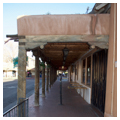You are here
La Hacienda Restaurant
Like the contemporary Ambrosio Armijo House, the Cristóbal Armijo House on the plaza’s south side reflects both the Americanization of Old Town after the arrival of the railroad, and its postwar redefinition as a tourist district in the Spanish Colonial Revival style. Built between 1880 and 1886 by a prominent Albuquerque banker and entrepreneur, the original two-story adobe structure had a hipped roof, projecting cornice with paired brackets, balustraded upper-story balcony, and portico with posts and bracing in the Queen Anne Style. The lower story was carved, plastered, and painted to duplicate the appearance of brick, while brick facing was applied to the second story, reflecting the widespread adoption of this material following the arrival of the railroad to New Mexico in 1878–1880. In response to Old Town’s reinvention as a tourist destination in the 1940s and 1950s, the building was then completely altered to mimic Spanish Colonial architecture. The hipped roof and upper story balcony were both removed, the exterior was coated in stucco, and the original portico replaced by a Spanish Colonial portal, with rough-hewn posts and beams, corbel brackets, and projecting vigas. The building now houses La Hacienda Restaurant.
References
DeWitt, Susan, “Old Albuquerque Historic District,” Bernalillo County, New Mexico. National Register of Historic Places Inventory–Nomination Form, 1980. National Park Service, U.S. Department of the Interior, Washington, D.C.
Johnson, Byron A. Old Town, Albuquerque, New Mexico: A Guide to Its History and Architecture. Albuquerque, NM: City of Albuquerque, 1980.
Writing Credits
If SAH Archipedia has been useful to you, please consider supporting it.
SAH Archipedia tells the story of the United States through its buildings, landscapes, and cities. This freely available resource empowers the public with authoritative knowledge that deepens their understanding and appreciation of the built environment. But the Society of Architectural Historians, which created SAH Archipedia with University of Virginia Press, needs your support to maintain the high-caliber research, writing, photography, cartography, editing, design, and programming that make SAH Archipedia a trusted online resource available to all who value the history of place, heritage tourism, and learning.




